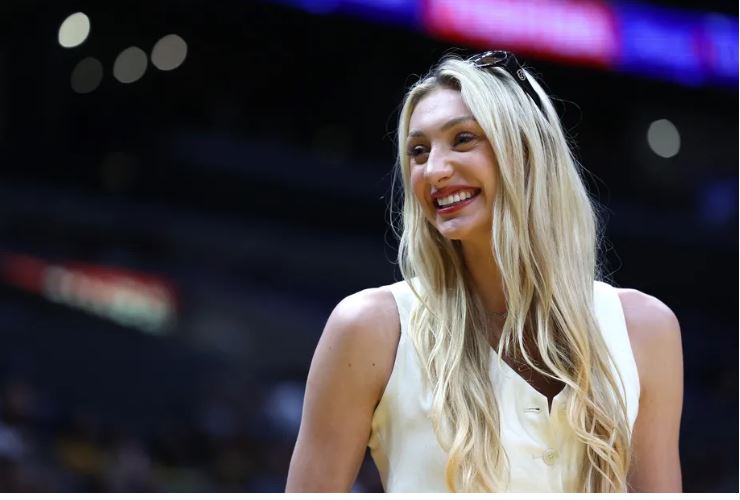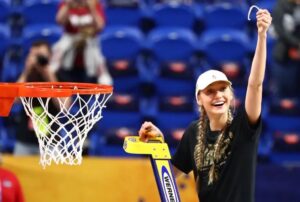

Cameron Brink’s rookie season in the WNBA was abruptly cut short when she suffered an ACL tear, but she reflects on the fifteen games she played with optimism and positivity. Brink’s debut year was marked by remarkable achievements, even though it ended prematurely. Just four minutes into a game against the Sun, Brink experienced the injury that would sideline her not only for the remainder of her rookie season but also for the chance to represent the U.S. Olympic 3×3 basketball team.
In a heartfelt Instagram post shortly after the injury, Brink expressed her disbelief and determination. She acknowledged the unexpected nature of the injury despite her hard work, but remained confident that it would ultimately make her stronger. The setback was significant, but Brink remained resilient and focused on the future.
During the time she was able to play, Brink made a notable impact on the court. She quickly established herself as a formidable defender, leading the league in blocks per 36 minutes and ranking third in blocks per game. This defensive prowess was a key factor in why the Los Angeles Sparks had selected her as the second overall pick in the draft, and it highlighted why she had been named the Naismith Defensive Player of the Year in her senior year at Stanford University.
In an exclusive interview, Brink discussed her focus on defense and her determination to continue improving. She admitted that while she had made significant strides, there was still much room for growth. Alongside her defensive skills, Brink also began to find her offensive rhythm, with standout performances including a 21-point game against the Wings and a 16-point outing against the Dream.
Despite the injury preventing her from facing every star in the league, Brink mentioned players like A’ja Wilson, Alyssa Thomas, and DeWanna Bonner as particularly challenging opponents. The depth of talent in the league was evident to her, making it clear that women’s basketball was thriving with exceptional players.
Brink’s rise to prominence began during her freshman year at Stanford, where she played a key role in leading her team to an NCAA championship. Her performance, including averages of 9.9 points, 6.6 rebounds, and 2.3 blocks per game, showcased her defensive instincts and potential as a future star in professional basketball. Her popularity grew throughout her college career, culminating in her substantial social media following, which now exceeds 1.3 million on Instagram.
The growth of women’s basketball and the ability for student-athletes to profit from their name, image, and likeness (NIL) under new NCAA policies played a significant role in Brink’s career. The opportunity for endorsement deals and media engagements became available to her following the policy change in July, shortly after her NCAA championship win. Brink’s success reflects the broader growth of women’s basketball, where increased visibility and financial opportunities for athletes have become more prominent.
Brink has been vocal about the evolving landscape of women’s basketball, acknowledging both the progress and the disparities within the sport. She has noted that certain players, particularly those who fit a specific appearance, have seen more benefits from the sport’s growth. Brink has expressed a desire for greater acceptance and inclusivity within the game, advocating for recognition based on talent and not appearance.
In her interview with SB Nation, Brink reiterated her commitment to advocating for her teammates and emphasized that the primary focus for players should be on their performance. While acknowledging that public opinions and biases exist, she believes that the best approach is to concentrate on playing high-quality basketball and continuing to support and uplift her teammates.
Brink’s success is not just a result of her individual efforts but also a culmination of her family’s influence and her own personal choices. Her parents, Michele Bain-Brink and Greg Brink, both played basketball at Virginia Tech, highlighting the long-standing connection between her family and the sport. Her mother’s experience as a “Title IX kid” underscores the significant strides made in women’s sports over the years.
Additionally, Brink made a crucial decision to undergo the EVO ICL procedure before her senior year of college, which corrected her nearsightedness and improved her performance on the court. The procedure alleviated the issues she had faced with contact lenses, making a significant difference in her athletic life and daily activities.
Despite the current pause in her rookie season due to the injury, Brink’s positive outlook remains steadfast. ACL injuries are common among female athletes, and many have successfully recovered and continued their careers. Brink’s resilience and optimism, combined with the support from her teammates and the lessons learned during her rookie season, position her for a strong comeback.
For now, Brink finds joy in supporting her teammates from the sidelines and remains hopeful about her future in the sport. Her journey, marked by both challenges and achievements, reflects her dedication and the ongoing evolution of women’s basketball.

Leave a Reply